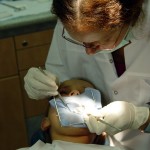
With the emergence new materials such as Calcium-based Silicate Cements (CSC), vital pulp therapy (VPT) is showing increasing evidence of success in the management of pulp exposure associated with carious lesions or symptomatic teeth with signs and symptoms of reversible or irreversible pulpitis. (American Association for Endodontists, 2021; European Society of Endodontology, 2019). The diagnostic terms of reversible and irreversible pulpitis are now being reviewed as the process of inflammation of the pulp in response to an insult may be more gradual with the pulp being able to retain some vitality with the adequate treatment being performed, such as VPTs (Wolters et al., 2017). The management of deep carious lesions falls under the realm of VPT with techniques such as selective caries removal or stepwise excavation. Although these techniques are promoting a conservative management for the pulp, it is not known whether procedures such as partial or full pulpotomy could provide more predictable outcomes (Leong et al., 2021).
The aim of this review was to explore outcomes of some certain VPTs and specifically answer, whether:
- direct pulp capping or pulpotomy is effective as selective carious-tissue removal in one-stage or stepwise excavation
- pulpotomy is effective as direct pulp capping
- pulpotomy is effective as a pulpectomy in patients with nontraumatic pulpitis associated with no or nonspontaneous pain.
Methods
A protocol was registered with PROSPERO and was developed, conducted, and reported using PRISMA guidelines. Searches were conducted in Clarivate Analytics’ Web of Science, including Web of Science Core Collection; WoS, Korean Journal Database; KJD, Russian Science Citation Index; RSCI, SciELO Citation Index; SCIELO, Scopus, PubMed (including MEDLINE) and Cochrane Central Register of Controlled Trials (CENTRAL) [Cochrane Library], including Embase, The Cumulative Index to Nursing and Allied Health Literature (CINAHL), ClinicalTrials.gov and the International Clinical Trials Registry Platform (ICTRP) database. Randomised control trials (RCTs), Comparative Clinical Trials as well as longitudinal observational studies (retrospective and prospective comparative cohort and case–control studies) exploring tooth survival following VPT as a primary outcome and published in English only, up to November 10, 2021, were considered. Authors also focused on pain outcomes, clinical and radiological outcomes, need for analgesia and Oral Health related quality of life (OHRQol). A number of 20 patients (10 in each arms) had to be included in the studies to meet selection criteria. Four independent reviewers paired in teams carried out study selection, data extraction and study quality assessment. The Cochrane risk of bias tool 2.0 was used. The data synthesis was presented with a narrative approach with a qualitative description of studies characteristics and methodological quality.
Results
- 3 RCTs reported in 4 publications were included.
- Studies were conducted in Denmark (multicentre study); India (single centre study) and Iran (single centre study)
- A total of 330 participants were recruited in the included studies.
- Included teeth had deep carious lesions, two studies focusing on vital mature molars while the other one did not specify the type of vital mature tooth.
- 2 RCTs investigated the effectiveness of pulpotomy (partial/full) versus direct pulp capping while one RCT compared the effectiveness between pulpotomy (partial/full) and pulpectomy.
- All 3 studies were considered at low risk of bias.
- Due to the small number of studies included and their methodological heterogeneity, a meta-analysis was not performed.
Conclusions
The authors concluded:
With strict criteria applied, a limited number of primary investigations were included, and we failed to conclude whether any of the VPTs of interest in this systematic review was superior to another, in fact no studies at all of direct pulp capping or pulpotomy (partial/full) compared to selective or stepwise caries removal were discovered. There were no significant differences in effectiveness as determined by either clinical and/or radiographic success, between pulpotomy (partial/full) and direct pulp capping or pulpectomy in managing nontraumatic pulpitis associated with no or nonspontaneous pain”
Comments
The protocol for this review is available on the PROSPERO and many major databases have been searched. The search strategy was limited to the English language because of time constraints according to the authors while they acknowledge further studies in other languages could have been included. A thorough and well-designed selection process led to a limited sample of studies which did not answer specifically the mains questions laid by the authors (PICOs). The authors highlight that none of the included studies investigated the most critical outcome: ‘tooth survival’. This emphasizes the current lack of evidence and need for high quality RCTs with less clinical and methodological variability. (El Karmin et al., 2021)
Links
Primary paper
Jakovljevic, A., Jaćimović, J., Aminoshariae, A. & Fransson, H. (2022) Effectiveness of vital pulp treatment in managing nontraumatic pulpitis associated with no or nonspontaneous pain: A systematic review. International Endodontic Journal, 00, 1– 15. Available from: https://doi.org/10.1111/iej.13776
Other references
Dental Elf – 8th Aug 2022
Dental Elf – 24th Sep 2021
American Association for Endodontists. (2021) AAE position statement on vital pulp therapy. Journal of Endodontics, 47, 1340–1344.
El Karim, I.A., Duncan, H.F., Cushley, S., Nagendrababu, V., Kirkevang, L.L., Kruse, C. et al. (2021) A protocol for the development of Core outcome sets for endodontic treatment modalities (COSET): an international consensus process. Trials, 22, 1–7.
European Society of Endodontology (ESE) developed by, Duncan, H.F., Galler, K.M., Tomson, P.L., Simon, S., El-Karim, I. et al. (2019) European Society of Endodontology position statement: management of deep caries and the exposed pulp. International Endodontic Journal, 52, 923–934.
Leong, D.J.X. & Yap, A.U. (2021) Vital pulp therapy in carious pulp- exposed permanent teeth: an umbrella review. Clinical Oral Investigations, 25, 6743–6756.
Wolters, W.J., Duncan, H.F., Tomson, P.L., Karim, I.E., McKenna, G., Dorri, M. et al. (2017) Minimally invasive endodontics: a new diagnostic system for assessing pulpitis and subsequent treatment needs. International Endodontic Journal, 50, 825–829.
